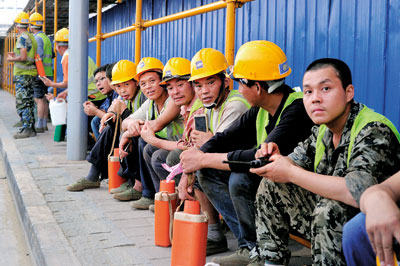Industry urges ‘accreditation’ for blue collar labour
View(s): Despite the plethora of cranes lining Colombo’s skyline, the construction industry that is struggling with higher demand is facing a greying, diminishing labour pool.
Despite the plethora of cranes lining Colombo’s skyline, the construction industry that is struggling with higher demand is facing a greying, diminishing labour pool.
The industry is also improving the working environment to lure people to join the construction sector, but perennial issues in labour in this industry have left a big question mark in attracting blue-collar labour, according to industry analysts. “We notice that Sri Lankans living in the country often choose low-paying office jobs over better remunerated opportunities in masonry, carpentry and plumbing. There is a social attitude about construction industry labour which is why young people fancy public sector jobs even if they pay much less,” an analyst told the Business Times.
The construction industry must re-engage at the student level, Access Engineering Managing Director Christopher Joshua noted at a recent forum.
In Sri Lanka the training of construction industry craftsmen is mainly carried out by several training institutions, which belong to the public and private sector. The public sector training institutions are the Vocational Training Authority (VTA), National Apprentice and Industrial Training Authority (NAITA), Department of Technical Education and Training (DTET), and the Institute of Construction Training and Development (ICTAD). But according to Mr. Joshua the curriculum in most of these is outdated.
In addition to the state entities, there are a few private sector training organisations such as the Chamber of Construction Industry Sri Lanka (CCI), Sanken Construction, Maga Engineering, Jayalath Construction Equipment Training, etc. These institutions have their own curriculum prepared for six to 18 month training courses. Mr. Joshua noted that Access too has started training.
By re-establishing and better educating students about vocational-technical schools and construction industry trade education, the industry may be able to attract the school leavers who are still undecided what they want to do after school, he said. Mr. Joshua said that an ‘accreditation’ should be awarded to the blue collar labour.

File picture of Chinese workers at a Colombo construction site.
Prime Lands Group Chairman and Co-Founder Brahmanage Premalal noted that there’s a big dearth for masons and tilers. Data shows that as of 2009, the direct employment in the construction industry was 562,000 persons. “This included four categories of employees: professional, technical, crafts, and machine operators.
Almost 97 per cent of total persons employed were males with 75 per cent falling in the 25-45 age-group. Some 52 per cent were with experience of less than five years,” an analyst who has done research on this said. He said that this isn’t sufficient.
Some firms are examining the greater use of machinery to replace manpower in some building procedures and adopt wider use of precast construction methods in an attempt to combat labour shortages, a second analyst added. Because retention is everything during a labour shortage, focusing on tech innovation is a tactic towards keeping employees and contractors happy, he added.


